Preface: Syrian government forces, backed by its ally Russian forces, continued their military escalation on cities and towns of Eastern Ghouta in Damascus countryside, despite signing sustained agreements on May 4, 2017, that identified de-escalation zones in Syria. Representatives of sponsored states in the Astana Talks (Russia, Turkey and Iran) signed Memorandum of Understanding/MOU/ to establish de-escalation zones[1] in Syria; one of the most important items of the agreement is that establishment of de-escalation zones will initially last 6 months, extendable automatically by consensus guarantor states. The agreement also states continuing the war against al-Nusra Front and the Islamic State organization, also known as ISIS, within and outside the de-escalation zones.
On July 22, 2017, Jaish al-Islam confirmed the De-Escalation zone agreement in Syria, followed by Failaq al-Rahman on August 18, 2017, as Russian side and Failaq al-Rahman agreed on ceasefire truce and keeping on fighting al-Nusra Front, according to many sources.
According to Syrians for Truth and Justice/STJ/ reporter, about 221 violations recorded committed by Syrian regular forces following the announcement of De-escalation zone agreement starting from May 4, 2017, until July 22, 2017, when Jaish al-Islam joined to sign the agreement. Syrian government forces backed by Russian forces launched military campaigns against some of Failaq al-Rahman-held areas in Eastern Ghouta, such as Jobar and Ein Tarma. However, some violations in Jaish al-Islam[2]-held areas also recorded, such as Douma.
On the other hand, about 500 violations recorded in various parts of Eastern Ghouta, starting from July 22, 2017, to August 18, 2017-when Failaq al-Rahman later joined to sign the agreement; Failaq al-Rahman-held Ein Tarma got most of the violations, while Jaish al-Islam-controlled areas recorded limited violations. STJ reporter documented about 223 violations from August 18, 2017 until the sixth round session of Astana Talks on September 14, 2017, where violations multiplied in Failaq al-Rahman-controlled areas, such as Ein Tarma and Jobar.
First: Indiscriminate Shelling on Civilians in Ein Tarma in Eastern Ghouta, Damascus Countryside, Declaring it Disaster Zone
Ein Tarma Located southeast Jobar neighborhood, is a center for Failaq al-Rahman back clash lines. Therefore, it witnessed part of the military campaign led by Syrian regular forces on Jobar neighborhood since June 2017, aiming to cut off supplies from the neighborhood, isolate it from the rest of Eastern Ghouta, and facilitate controlling it.
The town witnessed daily attacks, with various types of heavy and medium weapons, damaged civilians’ houses and caused dozens being dead and wounded, parallel with repeated attempts to break into it.
On August 3, 2017, the town, controlled by Failaq al-Rahman, was subjected to missile attacks resulted in killing a child identified as Aya, and a woman identified as Faten Idris, in addition to several wounded, according STJ reporter .
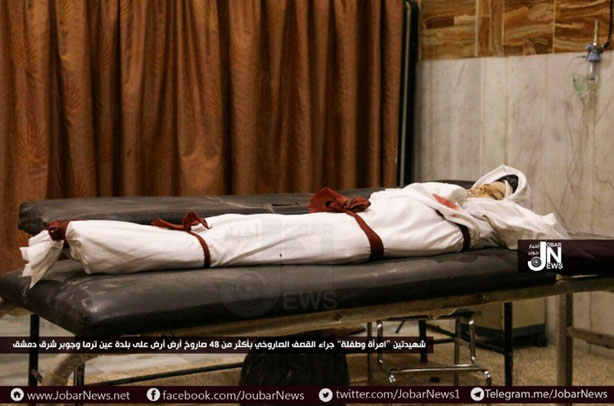
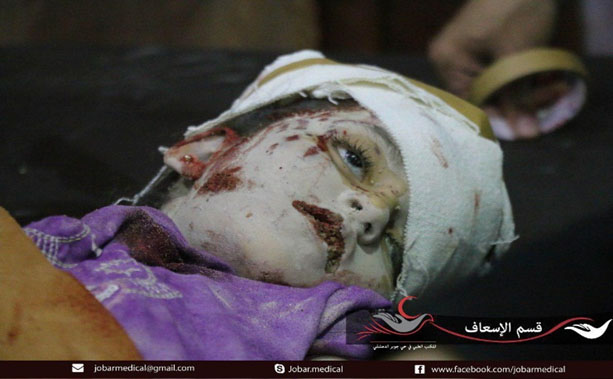
Two images show the victims Faten Idris and the child Aya whom were killed by missile attacks on Ein Tarma town on August 3, 2017.
Photo Credit: Facebook page of Jobar News network.
On August 2, 2017, the town experienced a similar bloody day, as regime forces targeted Ein Tarma with six airstrikes, killing two civilians identified as Mohammed Salah and Yasmeen Juha.
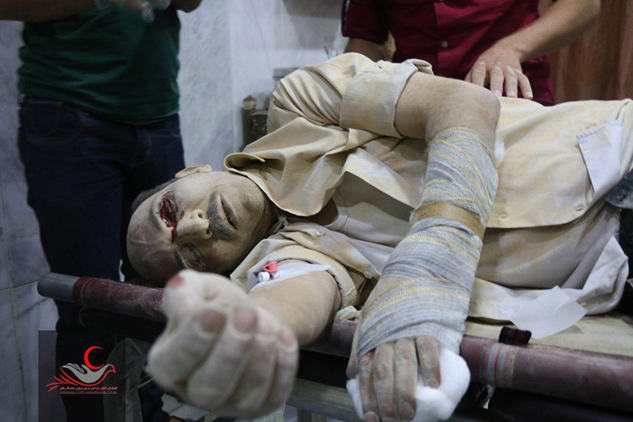
Image showing some of the injuried received in the Emergency Department at Jobar Medical Office as result of targeting Ein Tarma with ground-to-ground missiles on August 2, 2017.
Photo Credit: Facebook page of Jobar News network.
At 12:00pm, August 1, 2017, twenty high-explosive rockets targeted residential buildings in the town and the shelling lasted almost one hour, leading to fires in a building as well as killing five civilians, mostly children and women:
-
The child Lana Al-Qadi
-
The child Abdullah Al-Qadi
-
Haifa Bakoura
-
Amira Arqsusi
-
Suleiman Al-Dosouqi)
According to STJ reporter, hours after searching for the trapped under the rubble, the Civil Defense elements found a baby along with a disabled young man and transported them to medical centers for treatment and care.
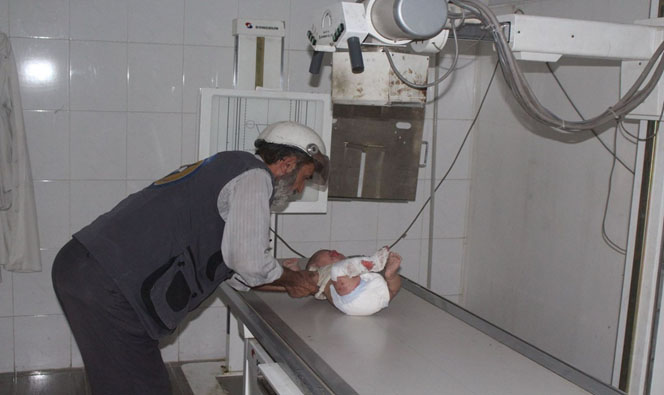
An image shows a side of treating the infant found under the rubble in the wake of the missiles attacks on Ein Tarma on August 1, 2017.
Photo credit: Facebook account of Syrian Civil Defense in Damascus countryside.
On August 1, 2017, a videotape published by Civil Defense in Damascus countryside showed pulling the disabled young man from under the rubble as a result of the rocket shelling on Ein Tarma on the same date.
On July 31, 2017, the Local Council of Ein Tarma issued a statement declaring the town as a disaster area, explaining the sufferings that the military campaign caused to civilians, and appealing for humanitarian institutions to prioritize the town as well.
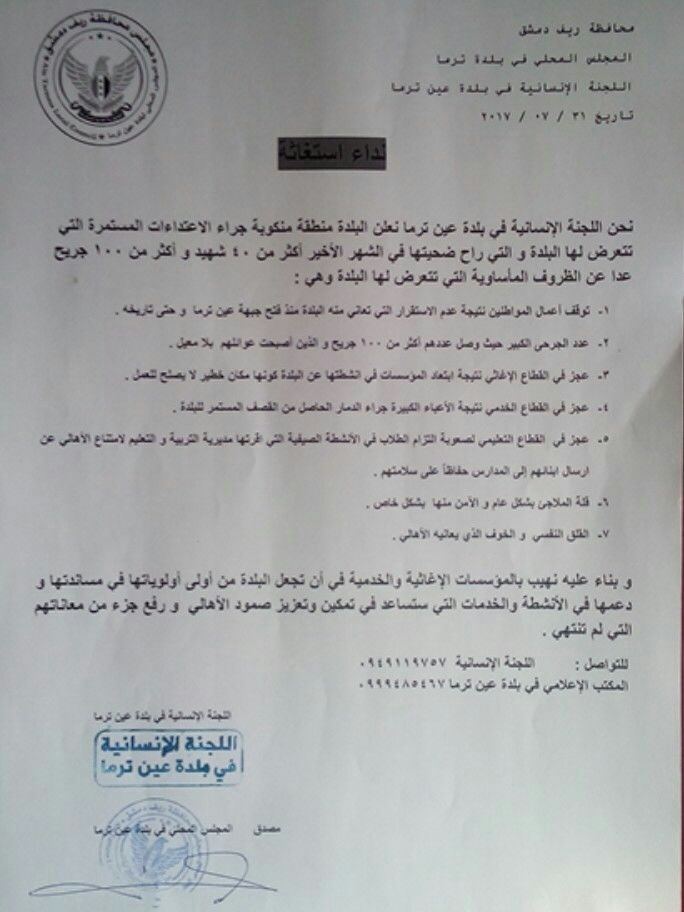
Image showing the statement issued by the Local Council in Ein Tarma on July 31, 2017, which declared Ein Tarma as a disaster area and demanded relief and humanitarian institutions to prioritize the town.
Photo credit: The Facebook account for the Local Council in Ein Tarma town.
Second: Civilians Massacre in Ein Tarma Town in Eastern Ghouta, Damascus countryside
On Friday morning, July 14, 2017, Syrian regular forces warplanes carried out eight raids on Ein Tarma town, collapsed a four-storey residential building as well as fires in one of its rooms. Despite the non-stop shelling, Civil Defense teams rushed towards the building, put out the fires and pulled civilians out of the rubble, in this regard, Muhannad al-Qasim, a Civil Defense member in Damascus countryside said:
"At about 08:45, Friday morning, Ein Tarma was struck by several air raids, targeting in the second raid a four-storey residential building in al-Assa area; the building was resided by civilians and was 2km away from the clash lines with the government forces with no headquarters of opposition factions nearby. Following the shelling, we, the Civil Defense team, rushed to the building to lift the civilians, we first attempted to pull the alive whom we heard their screams from under the rubbles. Indeed, after several hours, we were able to rescue 11 people, including women and children, and lift 11 corpses, and two days later, another body was found, raising the toll deaths to 12. "
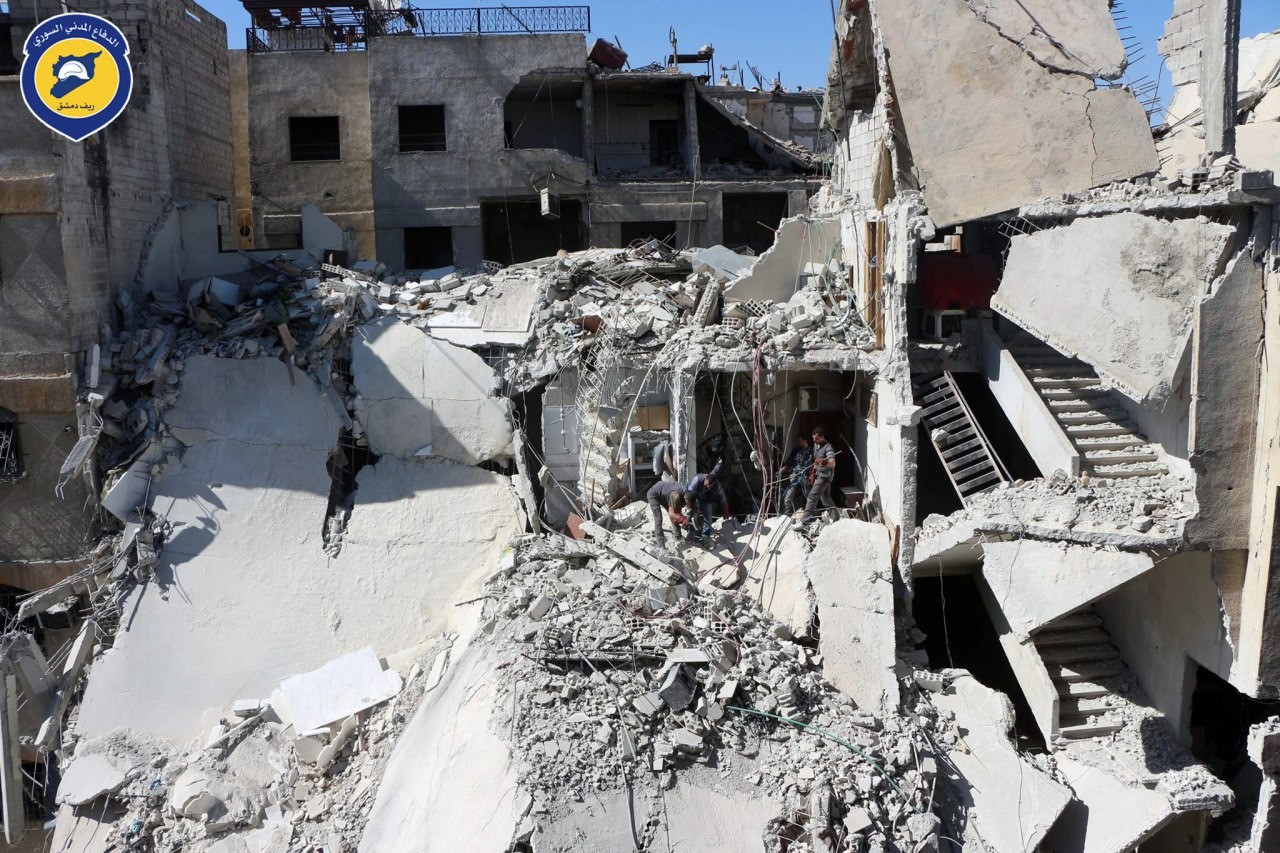
Image showing destruction of the targeted building in Ein Tarma by Syrian regular forces on July 14, 2017.
Photo Credit: Facebook account of Syrian Civil Defense in Damascus countryside.
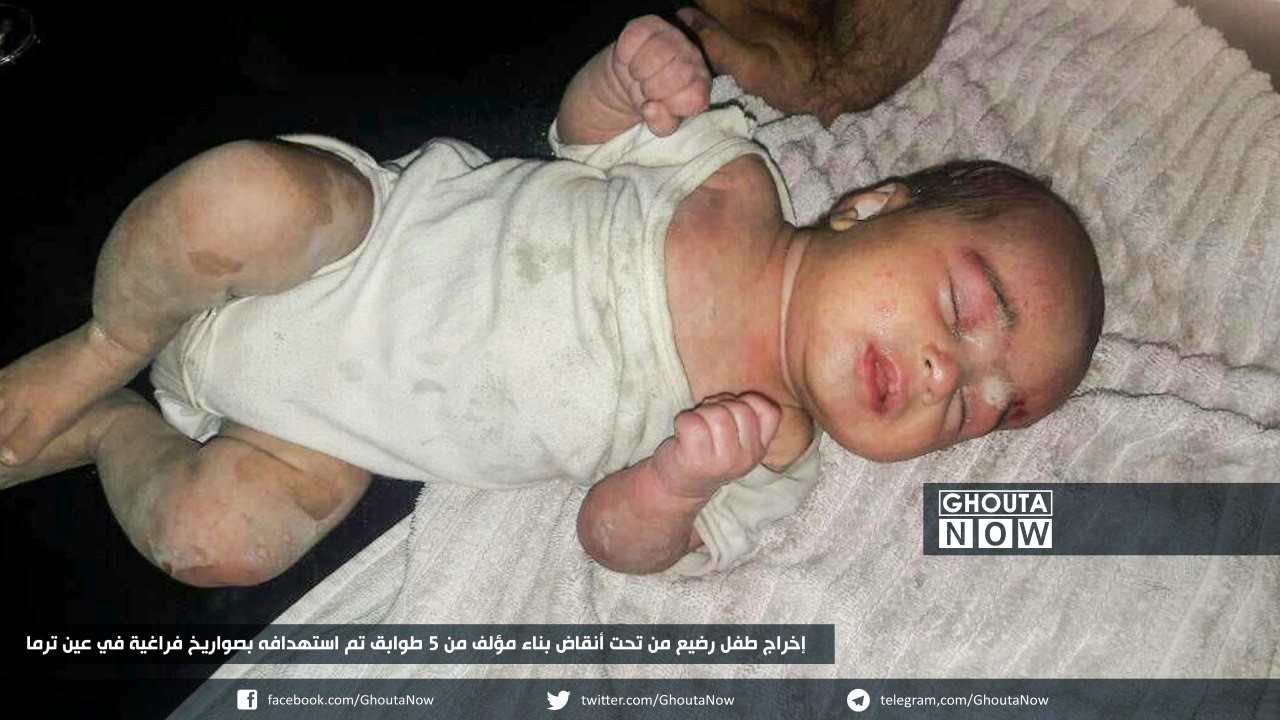
Image of an infant pulled out alive from under the rubble following the missile attack by Syrian regular forces on July 14, 2017,
Photo credit: Facebook account of Ghouta News Now.
In a related context, STJ reporter documented names of the dead in the missile attack on Ein Tarma on July 14, 2017, mostly women and children:
-
The child Mohammed Rahim
-
The child Ghiath Dahroj
-
-The child Ali Dadaa
-
The young Taghrid Murjan
-
The young Aliaa Bader Al-Deen
-
The young Nesrin Jarah
-
The young Mohammed Jawdat Santiha
-
The young Sulieman Tasliqi
-
The young Muhanad Ryhani
-
Ayman Al-Houmsi
-
An Unknown person
-
Abu Hussam, his real name is unknown.
A few days after the massacre, the Civil Defense documented the death of two other people due to their wounds, they are, Amid Al-Rawas and Batul Al-Sagheer.
A videotape published by Civil Defense in Damascus countryside showed attempts to put out fires that broke out in one of the corners of the building hit by aerial bombardment by Syrian regular forces on July 14, 2017. Another video tape published by Civil Defense elements in the same day, showed pulling of an alive woman from under the rubble of the building bombed by Syrian regular forces in Ein Tarma.
Third: Attacks Harvest Civilians Lives in Douma Town in Eastern Ghouta, Damascus countryside
Syrian regular forces did not spare Douma city from the violent attack carried out on areas and towns located in Eastern Ghouta in Damascus countryside. On July 12, 2017, Jaysh al-Islam Faction-held city was targeted by several artillery shells, killing a child identified as Habiba al-Shwk and a woman identified as Mounira al-Qasim, according to STJ reporter.
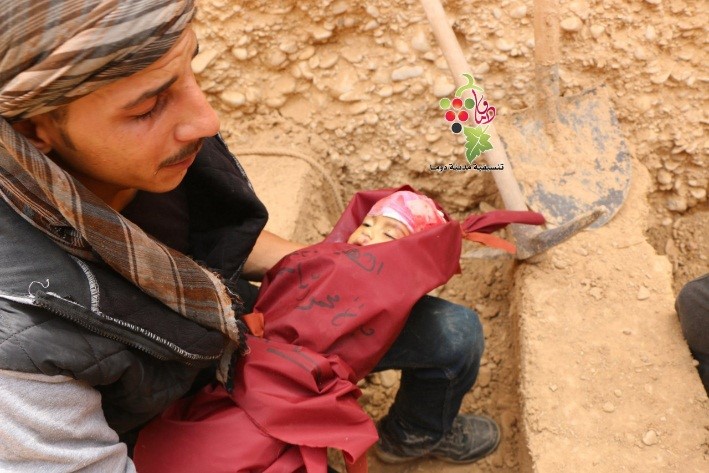
Image showing the moments prior burying the seven-month-old baby girl, Habiba al-Shwk, who was killed in shelling Douma on July 12, 2017,
Photo credit: The Facebook account of Douma coordination in Damascus countryside
Abu Mohammed, director of the Civil Defense in Damascus countryside, spoke to STJ about the escalating pace of shelling in Douma by Syrian regular forces since the beginning of July 2017, he said:
"On July 2, 2017, Douma was subjected to artillery bombardment which killed the child (Abdallah Wahbah) and injured two women. The next day July 3, 2017, regular forces stationed in the eastern mountains that overlook the city, targeted residential neighborhoods with several artillery shells, and killed a civilian identified as Basem Al-Houri and wounded other civilians with injuries varied from severe to medium. After that, the Syrian air force launched four raids on the city on July 4, 2017, which claimed the lives of both the children Mohammed Ludlow and Najwa al-Ajwa, apart from the material damage."
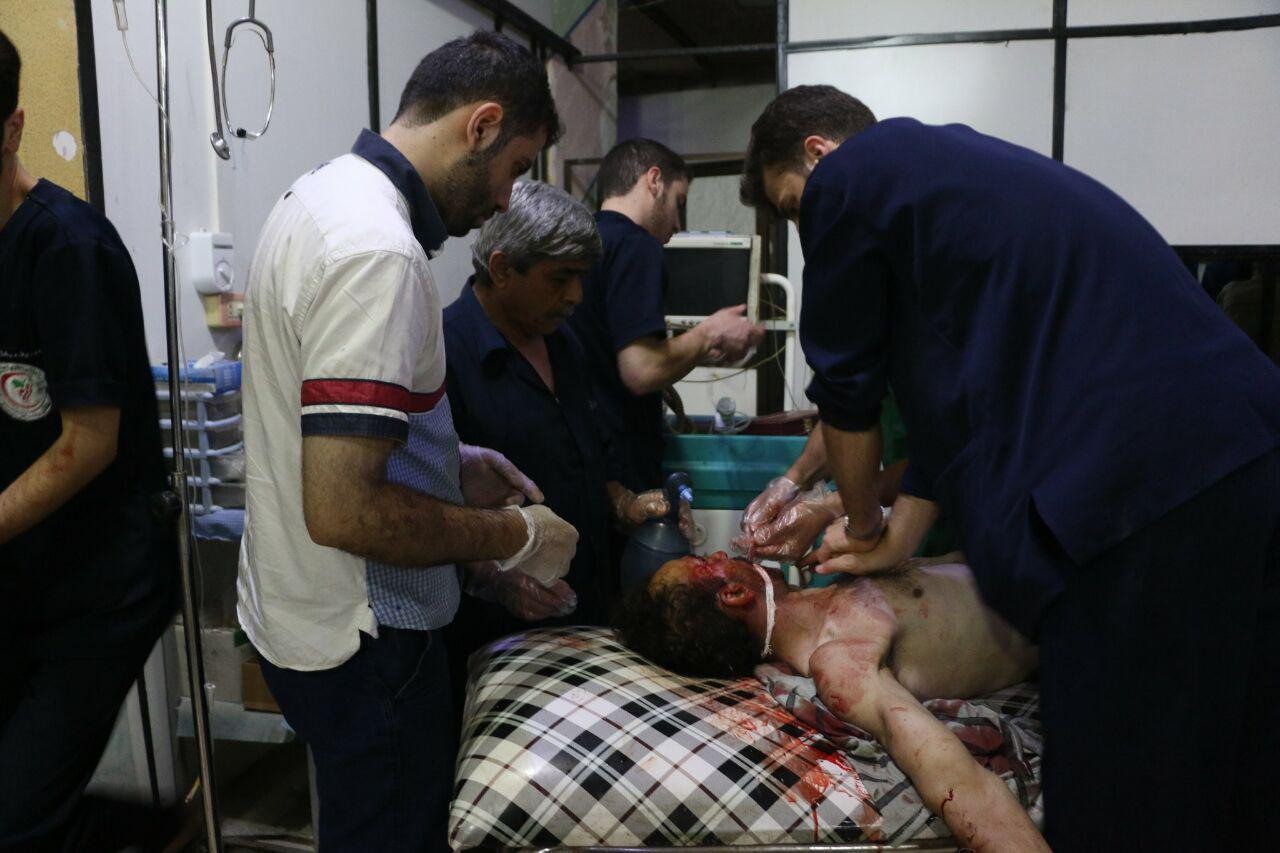
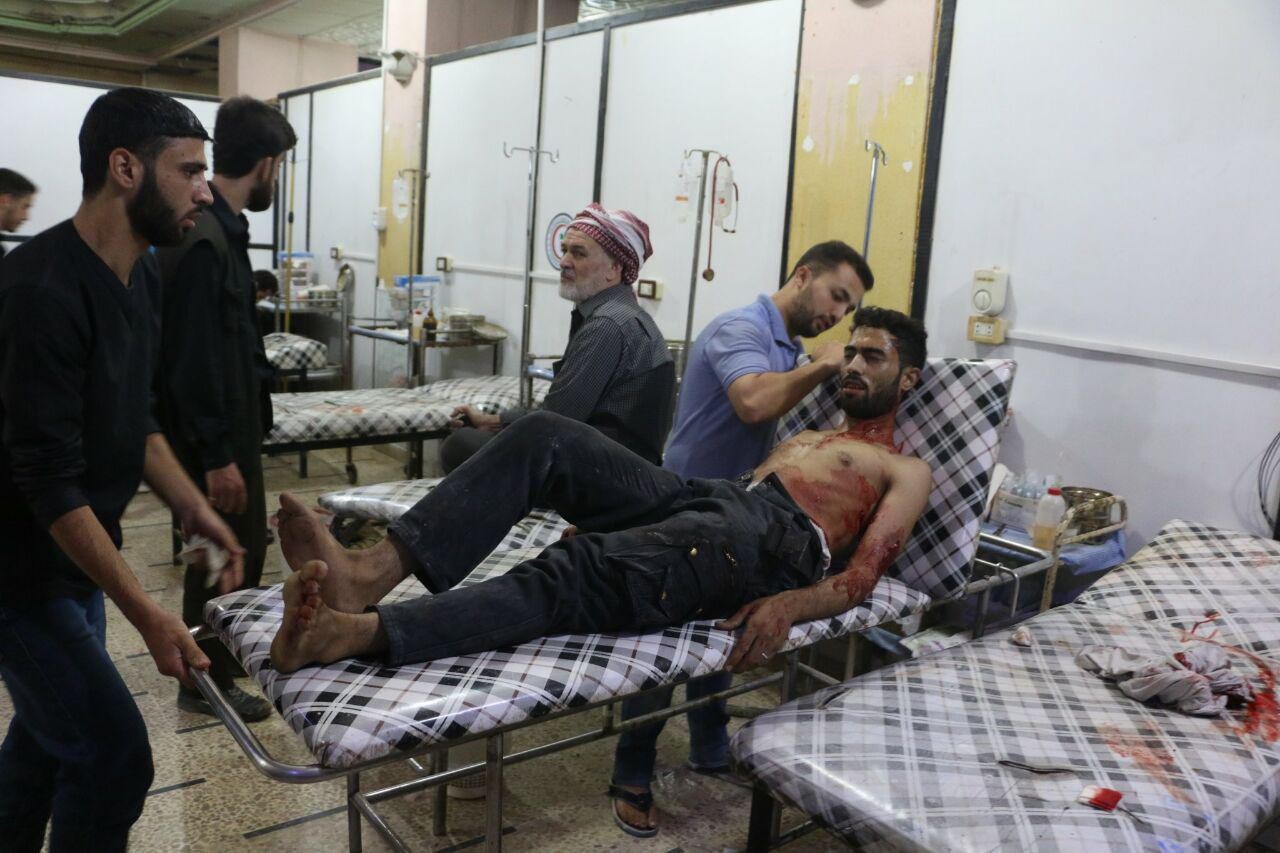
Images of the injuries dispatched to the Central Emergency Section in Damascus countryside Specialized Hospital following the artillery bombardment on the city on July 3, 2017,
Photo credit: Facebook account of the Medical Office of Douma.
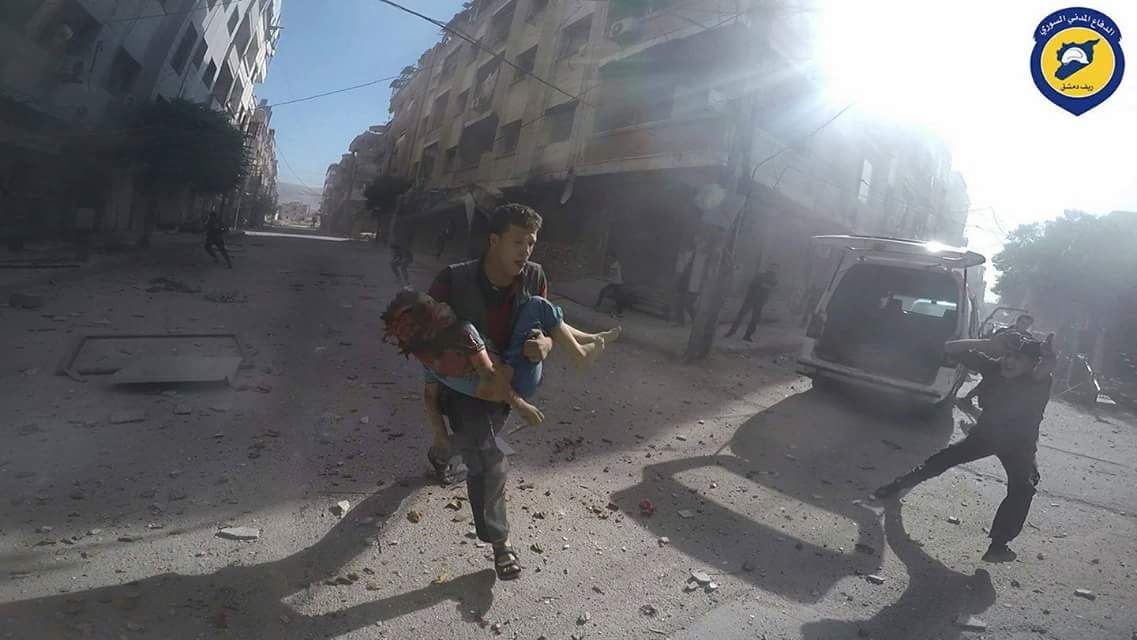
Image showing the first moments of Civil Defense members evacuating the dead and wounded. It shows a member evacuating the dead child (Muhammad Dalwan) from a neighborhood in Douma city after shelling it on July 4, 2017.
Photo credit: Facebook account of Syrian Civil Defense in Damascus countryside.
Fourth: Targeting Hazeh Town in Eastern Ghouta, Damascus countryside, Causing Civilian Casualties
On the other hand, the military campaign carried out by the Syrian regular forces was not limited to the mentioned areas, but expanded to other attacks in many areas. Apart from targeting Ein Tarma, a section of Hazeh town, located within Failaq al-Rahman-controlled areas, was targeted by several air raids in June 2017, including an attack on a residential building in the town on June 23, 2017, which killed five civilians, including women, children, and killed the media activist, Mahran Kargsley, alongside several injuries. In this regard, Um Salim, a woman witnessed the moment of the falling rockets on the residential building, said:
"On Friday morning, June 23, 2017, warplanes launched three air raids, the first on Zamalka town, the second near my area, whilst the third targeted the building opposite my house. The activist, Mahran Kargsley, was on top of that building filming the bombardment, on the upper floor from the same side where Mahran was standing; a family from Zamalka town was living in that building. Meantime, a thermobaric weapon hit the activist Mahran site, killed him at the spot alongside three persons from that family, they were identified as the child Janah Baghdadi, the mother Reem Mohammad ad-Dahban In addition to the brother Ali Baghdadi, while the father was seriously injured in addition to others. The toll of injured was about 10, besides an unknown woman."
STJ reporter conducted an interview with some of Hazeh residents who confirmed that the targeted area was free from any militarization of Syrian armed opposition.
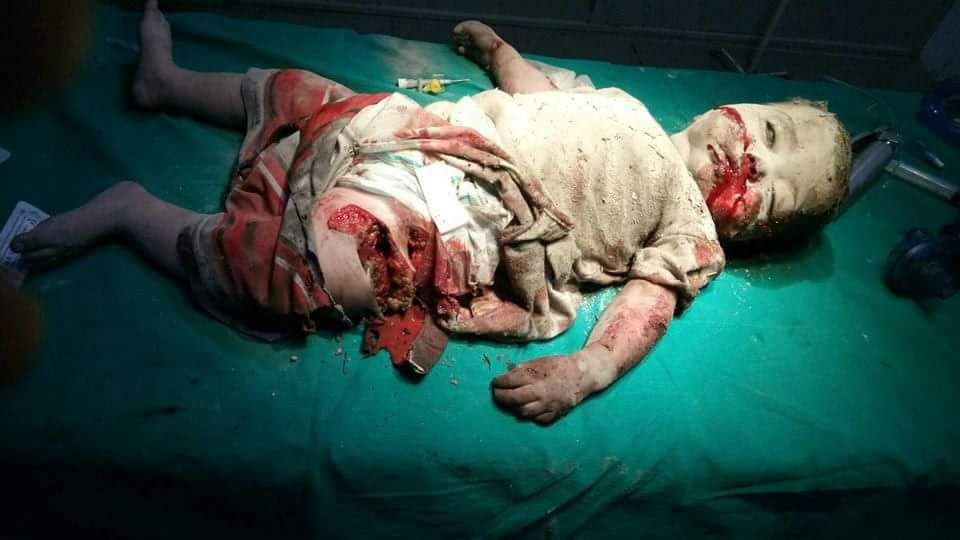
Image of the Baby Janah Baghdadi, who was killed in the aerial bombardment on Hazeh in Eastern Ghouta on June 23, 2017,
Photo credit: The Facebook account of Douma coordination in Damascus countryside.
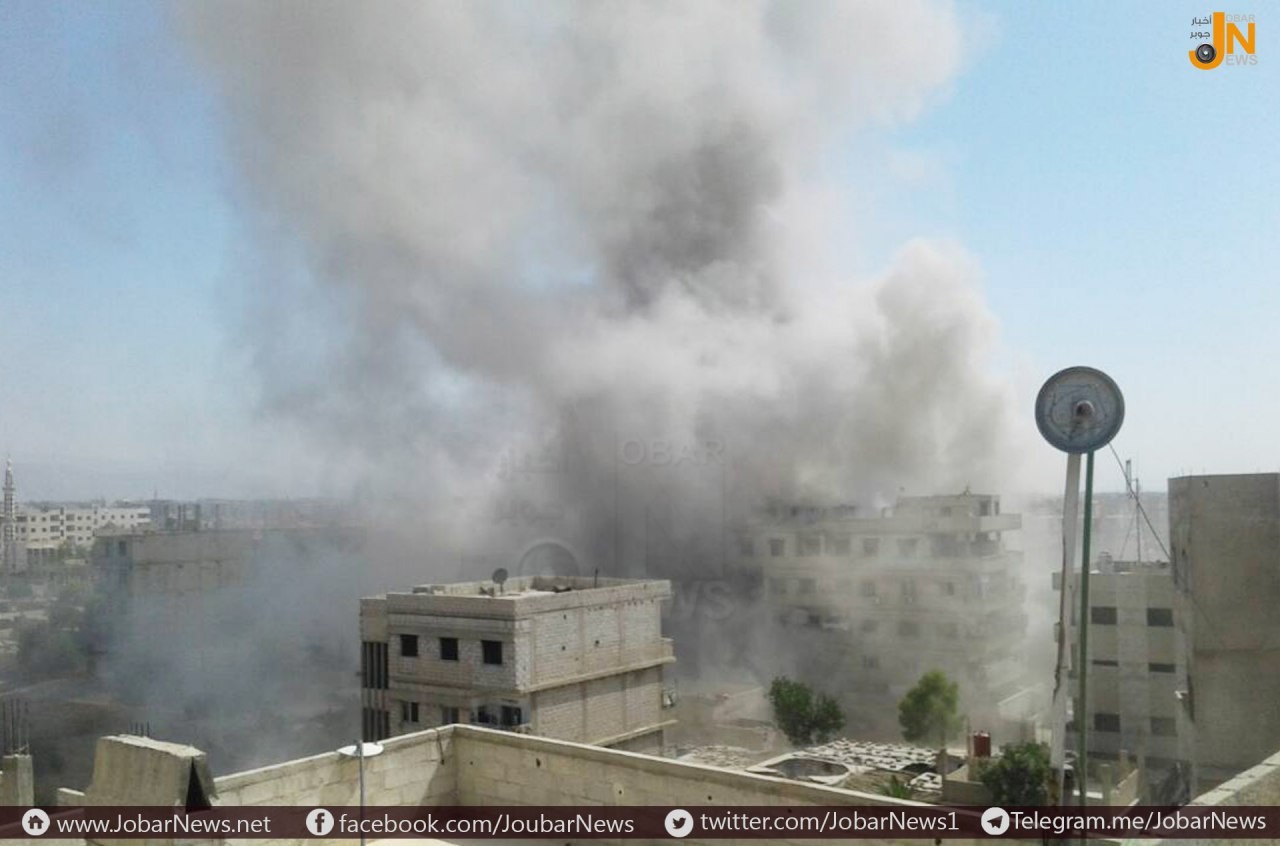
Image of the targeted building in the aerial bombardment on Hazeh town in Eastern Ghouta on June 23, 2017, which caused number of civilian casualties,
Photo credit: Facebook page of Jobar News network.
[1] Russia, Turkey and Iran, the guarantor states for the ceasefire in Syria, issued a joint statement on the mechanism of de-escalation zones, which includes according to the Memorandum on May 4, 2017, Eastern Ghouta, parts of northern Homs, Idlib province, and some Parts of adjacent provinces (Latakia, Hama, and Aleppo) and parts of southern Syria.
[2] In April 2017, Jaish al-Islam carried out a campaign lasted about a month to eradicate al-Nusra Front, and limit the presence of ISIS to few headquarters in the outskirts of Arbin and some parts of Hazeh and a section of al-Ash’ari farms, during the campaign Failaq al-Rahman convened to fight Jaish al-Islam, so the circle of military confrontations between Jaish al-Islam and Failaq al-Rahman expanded, and ended with retreatment of each faction into the areas it control, so regions of Douma, Mesraba, Autaya, A-Nashabiyah, Shifuniyah and some farms of al-Ash’ari became under Jaish al-Islam control, whereas Arbin is a joint control area between Ahrar al-Sham, Failaq al-Rahman and al-Nusra Front, while Hazzeh region is a joint control area between Failaq al-Rahman and al-Nusra Front, Hamouriya and Saqba regions became areas fully controlled by Failaq al-Rahman, Kafr Batna region became an joint control area between al-Nusra Front and Failaq al-Rahman, Jisreen, Zamalka, Jobar, Ein Tarma and Madyara are full control areas by Failaq al-Rahman and Harasta is a full control area by Ahrar al-Sham formerly Liwaa Fajr al-Uma.

